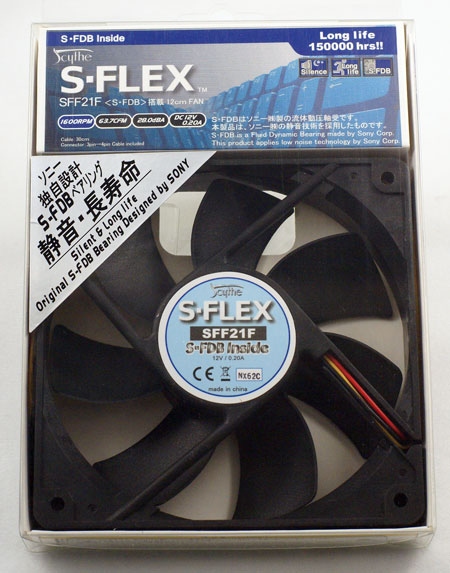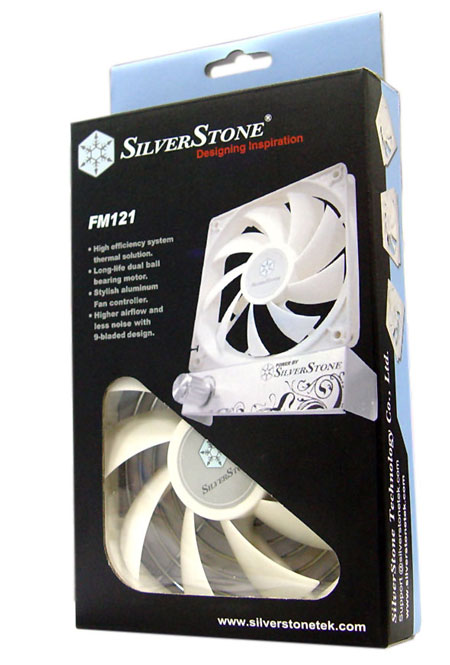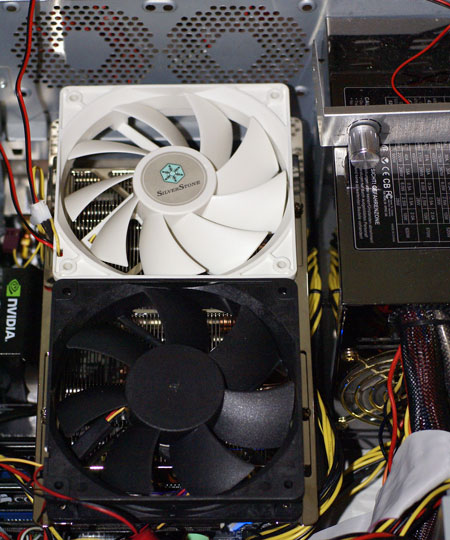Cooler Master GeminII: Performer or Poser?
by Wesley Fink on April 30, 2007 2:00 AM EST- Posted in
- Cases/Cooling/PSUs
Fan Configurations
While the Cooler Master GeminII does not ship with a cooling fan, the capability of mounting two 120mm fans on the cooler opens many possibilities. You can choose high-output fans for maximum airflow and theoretically the best performance, or you can choose two ultra-low noise fans for extremely quiet operation, or you can choose a combination of the two, such as a high output over the CPU and a silent fan over the memory area.
Since there are so many possibilities testing was performed with several configurations to assess the impact of different fan configurations on performance and noise with the Gemini II cooler.

We first tested with Scythe SFLEX SFF12F fans, which exhibit relatively low noise and high output. Two SFLEX fans were used, with each fan specified as 63.7CFM and 1600RPM at 28 dB-A.
The cooling is better than the stock Intel retail cooler and the overclocking extends a bit further at 3.83GHz compared to the 3.73GHz of the Intel retail cooler. However, these results with two fans do not really challenge any of the top coolers tested in cooling or overclocking ability.
One Scythe SFLEX was then swapped for the Silverstone FM121. This 9-bladed fan has variable output from 800RPM to 2400RPM. At 2400RPM output is an amazing 110.03CFM with noise at a less than silent 39.5 dB-A.

With the variable output you can choose silence and low output at 800RPM/17 dB-A, or you can go with noise and very high output at 2400RPM/39.5 dB-A, as well as all values in between. We tested cooling efficiency and noise with the Scythe SFLEX at full speed and the Silverstone FM121 at both 2400RPM and 800RPM.

It was amazing that the huge difference in fan output between the 800RPM and 2400RPM settings makes very little difference in overall performance of the GeminII. While temperatures were a 0C to 4C cooler with the high output fan at 2400RPM, the GeminII could still only reach a stable overclock of 3.85GHz. This compares to the better coolers with this CPU reaching 3.90GHz to 3.94GHz. Even more surprising was the fact that the low noise setting on the Silverstone FM121 combined with a quiet Scythe SFLEX still managed to reach a top overclock of 3.83GHz. This is just slightly less than the high output setting which also was exhibiting noise greater than 50 dB-A.
Finally the Cooler Master GeminII was equipped with two of the outstanding low-noise Noctua NF-S12 fans.

At standard voltage these fans are specified at 1200RPM with output at 50CFM and 17 dB-A. Lowering voltage with the U.L.N.A. reduces fan speed to 800RPM and noise to 8 dB-A. The pair of Noctua fans was run at full speeds with the pair of fans providing 100CFM of airflow on the Gemini II.
While cooling was 1C to 4C less than the super high output 110CFM fan, noise remained below the system noise floor with the pair of Noctua fans. Perhaps even more impressive was that we still managed to reach a stable 3.83GHz overclock - the same as all the other fan configurations except for the high output. The high output allowed an OC to 3.85GHz, which is just 20MHz more and hardly relevant.
It was concluded from testing four different fan configurations that the overclock limit for the Gemini II is around 3.83GHz, regardless of the fan configuration. This is certainly better than the stock Intel 3.73GHz, but it is far from the 3.9GHz to 3.94GHz we have reached in overclocks of the top coolers tested at AnandTech. The GeminII performance is below average for a top cooler and a disappointment.
If you do plan to use a GeminII in your system choose moderate output, low-noise fans for cooling. You might be tempted to use high output and super-high output fans in an effort to reach the best cooling possible, but the higher output fans make little difference on this cooler. High output fans dramatically increase noise - especially when using two with this cooler - but they do not improve performance very much.
While the Cooler Master GeminII does not ship with a cooling fan, the capability of mounting two 120mm fans on the cooler opens many possibilities. You can choose high-output fans for maximum airflow and theoretically the best performance, or you can choose two ultra-low noise fans for extremely quiet operation, or you can choose a combination of the two, such as a high output over the CPU and a silent fan over the memory area.
Since there are so many possibilities testing was performed with several configurations to assess the impact of different fan configurations on performance and noise with the Gemini II cooler.

We first tested with Scythe SFLEX SFF12F fans, which exhibit relatively low noise and high output. Two SFLEX fans were used, with each fan specified as 63.7CFM and 1600RPM at 28 dB-A.
| Dual Scythe SFLEX SFF21F | |||
| 2.93GHz | 3.73GHz | 3.83GHz | |
| Idle | 30 | 38 | 43 |
| Load | 41 | 54 | 58 |
The cooling is better than the stock Intel retail cooler and the overclocking extends a bit further at 3.83GHz compared to the 3.73GHz of the Intel retail cooler. However, these results with two fans do not really challenge any of the top coolers tested in cooling or overclocking ability.
One Scythe SFLEX was then swapped for the Silverstone FM121. This 9-bladed fan has variable output from 800RPM to 2400RPM. At 2400RPM output is an amazing 110.03CFM with noise at a less than silent 39.5 dB-A.

With the variable output you can choose silence and low output at 800RPM/17 dB-A, or you can go with noise and very high output at 2400RPM/39.5 dB-A, as well as all values in between. We tested cooling efficiency and noise with the Scythe SFLEX at full speed and the Silverstone FM121 at both 2400RPM and 800RPM.
| Silverstone FM121@2400RPM + Scythe SFLEX SFF21F | |||
| 2.93GHz | 3.73GHz | 3.85GHz | |
| Idle | 30 | 36 | 41 |
| Load | 38 | 50 | 56 |

| Silverstone FM121@800RPM + Scythe SFLEX SFF21F | |||
| 2.93GHz | 3.73GHz | 3.83GHz | |
| Idle | 33 | 38 | 41 |
| Load | 39 | 54 | 58 |
It was amazing that the huge difference in fan output between the 800RPM and 2400RPM settings makes very little difference in overall performance of the GeminII. While temperatures were a 0C to 4C cooler with the high output fan at 2400RPM, the GeminII could still only reach a stable overclock of 3.85GHz. This compares to the better coolers with this CPU reaching 3.90GHz to 3.94GHz. Even more surprising was the fact that the low noise setting on the Silverstone FM121 combined with a quiet Scythe SFLEX still managed to reach a top overclock of 3.83GHz. This is just slightly less than the high output setting which also was exhibiting noise greater than 50 dB-A.
Finally the Cooler Master GeminII was equipped with two of the outstanding low-noise Noctua NF-S12 fans.

At standard voltage these fans are specified at 1200RPM with output at 50CFM and 17 dB-A. Lowering voltage with the U.L.N.A. reduces fan speed to 800RPM and noise to 8 dB-A. The pair of Noctua fans was run at full speeds with the pair of fans providing 100CFM of airflow on the Gemini II.
| Dual Noctua NF-S12 | |||
| 2.93GHz | 3.73GHz | 3.83GHz | |
| Idle | 30 | 39 | 43 |
| Load | 39 | 54 | 58 |
While cooling was 1C to 4C less than the super high output 110CFM fan, noise remained below the system noise floor with the pair of Noctua fans. Perhaps even more impressive was that we still managed to reach a stable 3.83GHz overclock - the same as all the other fan configurations except for the high output. The high output allowed an OC to 3.85GHz, which is just 20MHz more and hardly relevant.
It was concluded from testing four different fan configurations that the overclock limit for the Gemini II is around 3.83GHz, regardless of the fan configuration. This is certainly better than the stock Intel 3.73GHz, but it is far from the 3.9GHz to 3.94GHz we have reached in overclocks of the top coolers tested at AnandTech. The GeminII performance is below average for a top cooler and a disappointment.
If you do plan to use a GeminII in your system choose moderate output, low-noise fans for cooling. You might be tempted to use high output and super-high output fans in an effort to reach the best cooling possible, but the higher output fans make little difference on this cooler. High output fans dramatically increase noise - especially when using two with this cooler - but they do not improve performance very much.










44 Comments
View All Comments
acejj26 - Monday, April 30, 2007 - link
Page 4...MHz, not GHzAnnihilatorX - Monday, April 30, 2007 - link
I have a feeling that the size of CPU coolers is directionaly proportional to the trend of global warmingDon't take this too seriously
Though the CPU TDPs are relatively constant at ~110W for high end CPUs, the coolers have been more and more elaborate.
Wesley Fink - Monday, April 30, 2007 - link
While TDP (Thermal Design Power or Thermal Design Point)has not varied a great deal recently, the wattage demands of a CPU in overclocking are MUCH higher than at stock speed, and they increase as the overclocking goes up as it dramaticlly does with the current Core 2 Duo processors. The more elaborate cooler designs are to effectively cool in the highest possible overclocking configuration OR to more efficiently cool with less air volume (noise reduction).We evaluate coolers using both these criteria - overclocking and relative noise.
Were we to evaluate coolers on just how well they cooled at rated CPU speed - which we do include in our reviews as "Stock Speed Performance" - our results table would likely look different and our recommendations would also be different.
pannivas - Monday, April 30, 2007 - link
Maybe I haven’t searched hard enough, but until now this cooler is the only cooler that can fit my Zalman HD135 HTPC case 130mm(H) and perform good as well as silently.stromgald - Monday, April 30, 2007 - link
The Thermalright XP-120 is also a good option for low-profile cases. I saw a review where it performed better than the Thermalright MST-6775, which is in this review, so I think it should be in the ball park of the Gemini II. It's also probably cheaper since it's smaller, and quieter since it only uses one 120mm fan.yacoub - Monday, April 30, 2007 - link
So basically if you're someone who is looking for a cooler that's average amongst the top aftermarket coolers in prowess, offers a lower height that should fit in just about any case, can mount twin 120mm fans, is practically silent in operation with the right fans, and directs airflow down over the board removing the need for an additional fan to do the that, it could be seen as a good product worth using?Wesley Fink - Monday, April 30, 2007 - link
If you need a shorter cooler this could be a good choice. It can definitely be "silent" with the right fan(s). It does cool much better than the Intel retail fan.thechucklesstart - Monday, April 30, 2007 - link
If you set up the fans in a pull configuration if it would increase cooling?Most vehicles have a pulling fan on their radiator because it is more efficient than a pushing fan and this situation seems similar.
Wesley Fink - Monday, April 30, 2007 - link
All Cooler Master diagrams and specifications show the fans mounted to blow air down toward the motherboard and components. We tested the fans mounted as Cooler Master specified. The fan wounting direction could be reversed if that is what you choose.BladeVenom - Monday, April 30, 2007 - link
I think it's would be worth testing. He's not the only one wondering if it might be better that way.